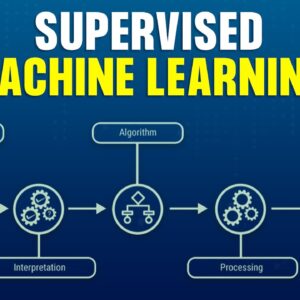If you’re looking to dive into the world of data science, there’s a good chance you’ve heard of supervised machine learning. This powerful technique is at the heart of many of the most innovative applications we use today, from image recognition to fraud detection and beyond. But what is supervised machine learning, exactly? In this post, we’ll take a deep dive into the different types of supervised machine learning, as well as the advantages and disadvantages of using this approach. Whether you’re a data scientist looking to brush up on your skills or a newcomer to the field, this post is a must-read!
Understanding Supervised Machine Learning: Types, Advantages, and Disadvantages
Introduction
Supervised machine learning is a subset of artificial intelligence that involves teaching a machine how to perform a task by providing it with labeled datasets. This popular type of machine learning involves the use of algorithms to learn from the data and make predictions based on that learning. In this article, we will explore the different types of supervised machine learning, their advantages, and their disadvantages.
Types of Supervised Machine Learning
Supervised machine learning can be divided into two main types:
- Classification
- Regression
Classification
Classification involves the use of a machine to predict into which category a particular set of data belongs. For example, sorting emails into “spam” or “not spam” is a classification task. There are several algorithms used for classification, including Decision Trees, Random Forests, and Naive Bayes.
Regression
Regression involves the use of a machine to predict a continuous value from a set of data. For example, determining the price of a house based on its size, location, and age is a regression task. Common regression algorithms include Linear Regression, Polynomial Regression, and Support Vector Regression.
Advantages of Supervised Machine Learning
Supervised machine learning has several advantages, including:
- Accuracy: Supervised machine learning algorithms can produce highly accurate predictions when trained on a large enough dataset.
- Efficiency: Once a machine learning model has been trained, it can be used to make predictions quickly and with minimal resources.
- Versatility: Supervised machine learning can be applied to a wide variety of fields, such as finance, healthcare, and marketing.
- Personalization: By using labeled data to train a machine learning model, businesses can create personalized recommendations for their customers.
Disadvantages of Supervised Machine Learning ###
Supervised machine learning is not without its disadvantages, such as:
- Overfitting: When a machine learning model is too complex or is trained on an insufficient amount of data, it can result in overfitting. This occurs when a model learns the training data too well, making it less accurate when used on new data.
- Bias: Supervised machine learning models can be biased if the data used to train the model is biased or incomplete. This can lead to inaccurate and discriminatory predictions.
- Lack of Creativity: Supervised machine learning models can only make predictions based on the data it has been trained on, so they may not be able to recognize new patterns or make creative predictions.
Conclusion
Supervised machine learning is a powerful tool that can be used to automate many tasks and improve accuracy in predictions. However, it’s important to be aware of its advantages and disadvantages when considering its use. With proper planning and use of appropriate algorithms, supervised machine learning can transform industries and provide innovative solutions to business problems.
FAQs After The Conclusion
- What is supervised learning?
- What are the two main types of supervised learning?
- What is overfitting, and how can it impact machine learning models?
- Can supervised learning models be biased?
- How can supervised learning improve business predictions?
